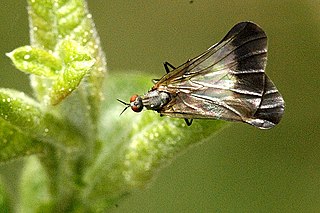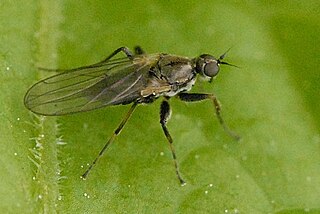
Empididae is a family of flies with over 3,000 described species occurring worldwide in all the biogeographic realms but the majority are found in the Holarctic. They are mainly predatory flies like most of their relatives in the Empidoidea, and exhibit a wide range of forms but are generally small to medium-sized, non-metallic and rather bristly.

Hybotidae, the typical dance flies, are a family of true flies. They belong to the superfamily Empidoidea and were formerly included in the Empididae as a subfamily.

Empis is a genus of dance fly found in the fly family Empididae.

Rhamphomyia is a genus of dance flies, in the fly family Empididae. It contains more than 600 species in 8 subgenera.

Tachydromiinae is a subfamily of hybotid flies widespread in the world.

Platypalpus is a genus of hybotid flies. It is worldwide in distribution, but best represented in Europe, with over 200 species. There are at least 580 described species in Platypalpus worldwide.

Leptopeza is a genus of flies in the family Hybotidae.

Ocydromiinae is a subfamily of hybotid flies.

Drapetini is a tribe of hybotid flies widespread in the world. There are 19 currently recognised genera. See the Wikispecies link below for details.

Hemerodromiinae are a worldwide group of predatory flies in the family Empididae with raptorial forelegs.

Empidinae, also called dance flies, are a subfamily of empidoid flies. They are mainly predatory flies like most of their relatives, and generally small to medium-sized. Most species are flower visitors and they can be effective pollinators.

Ragadidae is a family of true flies in the superfamily Empidoidea. It was formerly considered a lower taxon, but was published as a new subfamily within Empididae in 2016. Since then, it has been classified as the sister group to Empididae, and has been elevated to family level based on the genetic differences which separate it from Empididae.
Phaeobalia is a genus of flies in the family Empididae.
Wiedemannia is a genus of flies in the family Empididae.
Deuteragonista is a genus of flies in the family Empididae.
Hilarempis is a genus of flies in the family Empididae.
Sphicosa is a genus of flies in the family Empididae.

Chelipoda is a genus of flies in the family Empididae.
Chelifera is a genus of flies in the family Empididae.
Dolichocephala austriaca is a species of dance fly, in the fly family Empididae.










